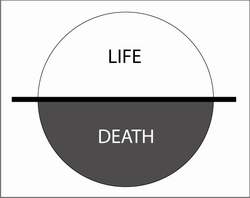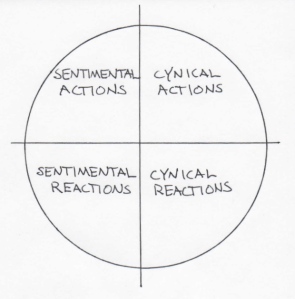Harmonic Sentimentality Part 6: Why H.S. is Possible
by hughestim665
Phew. So now you’re wondering how it’s possible to so consistently incorporate a fairly complex idea like Harmonic Sentimentality within a syndicated television series. The answer lies in circles. Harmon is a staunch proponent of his particular story model which he modeled very closely off of Joseph Campbell’s Monomyth which follows the journey of the archetypal hero. I’m going to skip the more intense history lesson of Campbell’s research and jump right into how Harmon uses the model. First, draw a circle. So far so good. Now draw a horizontal line through it. Perfect. The top of that circle represents where the character’s journey starts and finishes. The bottom represents the world that needs to be traversed in order to grow and change. Every story has a rhythm, a balance, or a resonance. This is what creates stories, the idea that things can go one way or another. Dualities exist. Take, for example, the story of life. You’re alive, then you’re dead. Then your dead body decomposes and feeds plants, giving new life. Which then dies. That’s a story. It goes one way, then another, then back, then forth. There’s a balance. Harmon explains all this, with many more poignant examples, in his tutorials (http://channel101.wikia.com/wiki/Story_Structure_101:_Super_Basic_Shit ). Here we see the rhythm of life on our bisected circle:
We’ve established that there exists dualities within the world, and that stories are created when you move between the two dualities. But how does one venture between the dualities in order to create a story? Here, things get slightly more complicated but should still be manageable. Campbell broke down the journey that creates heroic stories into sections. Harmon took it one step further by simplifying it as much as possible. Now draw a vertical line down the center of your bisected circle. We now have four intersections and four spaces or quadrants. Label the intersections starting at 12 o’clock and going clockwise 1,3,5,7, and label the quadrants, again clockwise, 2,4,6,8. This is Harmon’s 8-point story circle:
Fantastic. Let’s put some words on this bad boy. The numbers correspond to very basic concepts:
- You (A character is in a zone of comfort)
- Need (But they want something)
- Go (They enter an unfamiliar situation)
- Search (Adapt to it)
- Find (Get what they wanted)
- Take (Pay a heavy price for it)
- Return (Then return to their familiar situation)
- Change (Having changed)
Let’s stretch these things out a little bit and explain them further:
- There exists a character or a protagonist. Let’s call him Jeff Winger. He lives in a world that he knows about.
- Things are OK for Jeff, but they could be better. He wants to make them better for one reason or another.
- Jeff is beginning to take steps that will hopefully make his life better. He’s crossing the threshold from a world he knows, to a world that he’s unfamiliar with, one that he might not be equipped to handle.
- Jeff is tested in this new world. He’s learning if he is equipped to handle the new situation.
- Jeff finds what he’s looking for, the thing that will make his life better. This could be a quarter on the ground or maybe a really great conversation. In Campbell’s world, this is the Meeting with the Goddess.
- Jeff is now atoning with the life he once lived. He understands that this New Jeff is worth losing the Old Jeff for. He’s understanding that he has more or less lost what he once was. There’s no going back now. He is tested again to see if New Jeff is capable enough to operate in his old world.
- Jeff returns to his old world.
- He has changed into New Jeff and now acts in his old world, possibly changing that world because of how he has changed.
So that’s Harmon’s story circle. If you want a much more comprehensive, informative and entertaining run-down, again, check out Harmon’s tutorials.
Before we move on, let’s recall the Hegellian Dialectic that exists within Harmonic Sentimentality:
Thesis: Cynical + Actions
Antithesis: Sentimental + Reactions
Synthesis: Sentimental + Actions
And now let’s put this onto Harmon’s story circle in a simplified, step by step process. If the threshold you want to cross is between a character’s actions and reactions, the first step will look like this:
Now, let’s say we want that character to turn from a cynical person into a sentimental person. Now we have this:
Finally, combine the two:
Now in English:
- A character is cynical.
- Things happen, and he reacts in a cynical way.
- More things happen, and he now reacts in a sentimental way.
- The character is now sentimental.
In order to get this into the 8-point story circle format, it would be necessary to add specifics to actually create a detailed, grounded, real world story. But for simplicity we can just leave it like that. Let’s look at a slightly different, less abstract Dialectic that is closer to the definition of Harmonic Sentimentality:
Thesis: Cynical Person + Cynical World
Antithesis: Sentimental Person + Sentimental World
Synthesis: Sentimental Person + Cynical world
And now visually:

Let’s break this one down on the 8-point story circle:
- There was a cynical person in a cynical situation.
- Something happens that makes them want something.
- They act cynically.
- They are seeing that their cynicism isn’t helping them get what they want.
- Sentimentality is introduced to the cynical person.
- They come to the general realization that sentimentality is better than cynicism. They test out this theory.
- They return to their cynical situation.
- They act sentimental. They realize that they can use sentimentality in their cynical situation, and they do. They have changed to a sentimental person.
In terms of the three part definition of Harmonic Sentimentality, how do they correspond to Harmon’s 8-point story circle? Easy: Steps 1-4 of Harmon’s circle correspond to Part (1) of H.S. Step 5 of the circle, or the Meeting of the Goddess, corresponds to Part (2) of H.S. Steps 6-8 of the circle correspond to Part (3) of H.S.
It should be pretty obvious by now that Harmon’s story circle and Harmonic Sentimentality go hand in hand. Whether Harmonic Sentimentality was a conscious effort within the writer’s room, and I just put a name to it, is a mystery to me. I don’t know if a requirement for every successful story circle/plot line in Community was that a cynical person becomes sentimental, but it wouldn’t surprise me if it was given the mountain of evidence supporting it. I am sure, however, that Harmonic Sentimentality is only possible because of Harmon’s story circle. Harmon is on record multiple times in heralding the importance of the Meeting with the Goddess stage of his circle, which corresponds to Part (2) of H.S. The reason why this point is so important is because it is the thing that changes the person from being Cynical to being Sentimental. In Harmon’s circle, it’s what sends them back to their familiar situation having changed. In terms of storytelling, this point could literally be anything as along as it gets the job done. It needs to undress the character to the point where they’re basically being reconstructed from scratch and then thrown back into reality anew. In Campbell’s world, it’s akin to floating through space for an infinite time in order to bring the hero someplace that’s seemingly impossible to get to. It doesn’t matter what needs to happen to get the character to this new point as long as it happens. It is absolutely 100% crucial to the existence of Harmon’s circle as well as Harmonic Sentimentality. The after effect, the change, is just gravy from then on out. Change is the endgame but how the change occurs is the real meat and potatoes.
For some, Harmon’s circle can be considered counter-intuitive. When you break it down into quadrants, the idea of moving clockwise around the circle appears as if the character is backtracking in terms of physical ground covered. It’s more important to view the circle as a vertical journey rather than a horizontal one. The character goes down into a world that he’s unfamiliar with and then rises back up bringing things he’s learned back to his familiar world. In Harmon’s tutorials, he uses the analogy of the top half of the circle being the upstairs of a house and the bottom half being the basement. In order for the upstairs to work properly, we occasionally have to go into the basement to check the water heater or the fuse box and bring that information back upstairs where we can call the plumber or electrician to tell them something is wrong.
An un-obvious thing that occurs with Harmon’s circle, Hegellian Dialectics, and Harmonic Sentimentality is that when each individual circle, Dialectic or Sentimentality is complete, that doesn’t mean the story of the character is over. Life is complex. Millions of stories happen for everyone. One story circle is just one thing we see in an infinite line of story circles. For Dialectics, it’s possible that the synthesis of one Dialectic will act as the Thesis for the next. For Harmonic Sentimentalities, one character’s realization can act as another character’s act of sentimentality (happens all the time in Community). The point is, these individual stories should be viewed as cross-sections of the character’s life. They’re never the end point for the character. Think of watching an episode of TV as a way of peeking in on a person’s life for 22 minutes, and when those 22 minutes are through, the character continues their life just without you watching them. It’s weird, I know, but it helps with realizing that story circles go on forever. If the finite visual of completing a revolution of a story circle is too difficult to get past, it’s possible to view it as a cosine wave. I’m not going to get into this but Chris Woo, a blogger, explains this theory here: (http://www.chrisdwoo.com/post/60307732278/more-on-dan-harmons-story-circle-and-my-theory-it-is ). He also momentarily dips into Hegellian Dialectics to help justify his cosine theory. For me, a circle works just fine.
Now let’s get weird. Let’s take Harmon’s story circle and apply it to postmodernism and post-postmodernism:
- Postmodernism exists in the mainstream.
- People want something more out of postmodernism.
- They try to use cynicism and irony in new ways.
- They’re starting to see the pitfalls of cynicism and irony. They’re almost there.
- Transitional stage between postmodernism and post-postmodernism (our present state). Community is created showing the power of sentimentality.
- The beginning stages of post-postmodernism: creatives are using/experimenting with different forms of sentimentality.
- A clear, more highly developed form of sentimentality reaches the mainstream.
- The mainstream changes from being in postmodernism to being in post-postmodernism.
Here, steps 1-4 would be postmodernism. Step 5 would be Community, where we are right now. Steps 6-8 would be the emergence of a clearly defined post-postmodernism. Dan Harmon took the plunge, he met the Goddess, and he’s bringing back the boon of sentimentality.





[…] Part 6: Why Harmonic Sentimentality is Possible […]